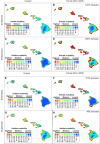Consequences of Climate Change on the Emergence of Pathogenic, Environmentally Acquired Nontuberculous Mycobacteria
- PMID: 41141439
- PMCID: PMC12548797
- DOI: 10.1093/ofid/ofaf232
Consequences of Climate Change on the Emergence of Pathogenic, Environmentally Acquired Nontuberculous Mycobacteria
Abstract
Background: Climate change, manifested by global warming, unpredictable precipitation, and increased frequency and severity of catastrophic weather, is a growing health threat. However, the impact that climate changes pose to environmental bacteria is not fully recognized.
Methods: To understand pathogen response to climate change, we interrogated nontuberculous mycobacteria (NTM) on a continental scale using open-source data products including Surface water microbe community composition data, soil microbe community composition data, and 16S ribosomal RNA (rRNA) gene sequences provided by the National Ecological Observatory Network (NEON) between 2015 and 2018.
Results: Of 6343 soil and water samples, 81.8% were positive for mycobacteria; soil samples had a higher positivity rate. NTM were also identified among a subset of 31 archived DNA samples, albeit in low proportion (6.5% [n = 2]). Viable Mycobacterium chelonae and Mycobacterium arabiense were recovered from 3.7% (3 of 81) biobanked NEON soil and aquatic sediment samples. Finally, using geographic coordinates of NTM from work in Hawai'i (a geographic hot spot for NTM infections), we modeled habitat associations during current and future climates. We found that the potential ranges for NTM are forecast to increase under future climate conditions and are strongly associated with increases in temperature, with pathogenic species accounting for most of the predicted surge.
Conclusions: Very little is known of the possible negative climate impacts on the emergence of disease due to environmental microbes. These data support the notion that NTM prevalence may be heavily augmented by climate change resulting in expansion into new geographic niches and posing new clinical consequences for humans.
Keywords: NEON; climate change; infectious disease; natural environment; nontuberculous mycobacteria.
© The Author(s) 2025. Published by Oxford University Press on behalf of Infectious Diseases Society of America.
Conflict of interest statement
Potential conflicts of interest. All authors: No reported conflicts.
Figures




References
-
- Wang Z, Pei S, Cui H, Zhang J, Jia Z. Zoonotic spillover and extreme weather events drive the global outbreaks of airborne viral emerging infectious diseases. J Med Virol 2024; 96:e29737. - PubMed
-
- Honda JR. Environmental sources and transmission of nontuberculous mycobacteria. Clin Chest Med 2023; 44:661–74. - PubMed
LinkOut - more resources
Full Text Sources

